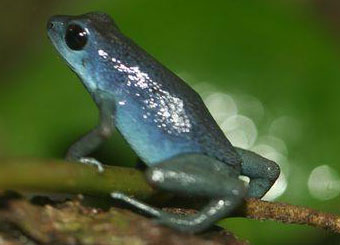Facing extinction, amphibians fail to cope with global warming
Facing extinction, amphibians fail to cope with global warming
mongabay.com
April 30, 2007
Despite surviving the age of dinosaurs and numerous bouts of severe climate change, amphibians are not keeping pace with the current rate of global change, reports a new study published in the journal Bioscience.
“We know that there are various causes for amphibian population declines, including UV-B light exposure, habitat loss, pesticide pollution, infections and other issues,” said Andrew Blaustein, author of the study and a professor of zoology at Oregon State University. “But looked at in a different way, it’s not just that there are threats and pressures amphibians have to deal with. There have always been threats, and these have been some of the most adaptive and successful vertebrate animals on Earth. They were around before the dinosaurs, have lived in periods with very different climates, and continued to thrive while many other species went extinct. But right now, they just can’t keep up.”
 |
More than a third of the world’s 5,743 known species of amphibians are threatened, while 168 species are believed to have gone extinct in recent years. Blaustein says that amphibians are especially at risk “because their physiology and complex life cycle often exposes them to a wider range of environmental changes than other species must face — they have permeable skin, live on both land and water, their eggs have no shells.”
“Historically, amphibians were adept at evolving to deal with new conditions,” Blaustein said. “What they are doing is showing us just how rapid and unprecedented are the environmental changes under way. Many other species will also be unable to evolve fast enough to deal with these changes. Because of their unique characteristics, the amphibians are just the first to go.”
Blaustein and colleagues report that the adaptations amphibians evolved over millions of years have now turned against them as their habitats are increasingly polluted, the ozone layer thins, and climate changes at rates far greater than in the past.
 |
“Although relatively rapid evolution may occur within some amphibian populations when a novel threat arises, other threats may be too intense and too new for amphibians to cope with them,” the researchers wrote in their report. “Behaviors and ecological attributes that have probably persisted, and were probably beneficial, for millions of years… under today’s conditions may subject amphibians to a variety of damaging agents.”
Blaustein says that amphibians may eventually adapt the changing conditions–provided they survive the extinction bottleneck.
Related articles
Frogs avoid damaging UV-B radiation, reducing extinction risk. Poison arrow frogs appear to make special effort to avoid exposure to damaging ultraviolet-B radiation, according to research published in the journal Biotropica. The findings are significant in light of increasing levels of UV-B radiation due to ozone depletion.
Bad news for frogs; amphibian decline worse than feared. Chilling new evidence suggests amphibians may be in worse shape than previously thought due to climate change. Further, the findings indicate that the 70 percent decline in amphibians over the past 35 years may have been exceeded by a sharp fall in reptile populations, even in otherwise pristine Costa Rican habitats. Ominously, the new research warns that protected areas strategies for biodiversity conservation will not be enough to stave off extinction. Frogs and their relatives are in big trouble.
This article is based on a news release from Oregon State University














